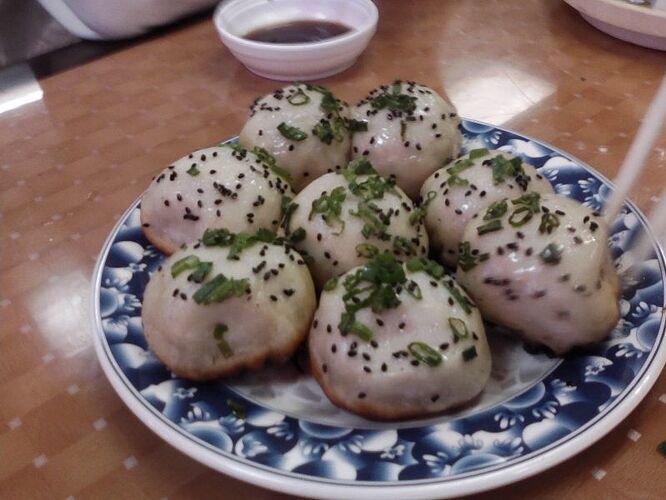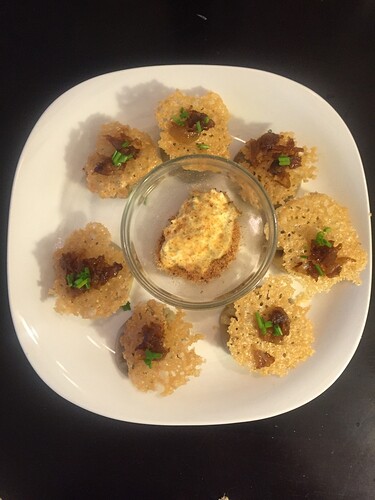if you’re basically going to make an aspic to use to fill the dumplings, why not forego the baked chip and include a small cube of gruyere/emmentaler inside each dumpling so as it melts it thickens the liquid like a regular onion soup? of course if it’s really hot, it’s going to travel down the esophagus at a pretty slow pace making it even worse…
[quote=“ebethsdad, post:17, topic:3449”]unless @secretasianman, @JThur01, @ipsedixit, or @chandavkl says otherwise
[/quote]
to me, every type of dumpling has its own set of aesthetics, requiring a certain level of deftness/technique to produce them. if you are in a region where cold weather is the norm, something substantial with a thick chewy dough where carbo-loading is part of the goal might have more appeal.
XLB are probably the daintiest, but there are IMO fewer good renditions of shui jian or shen jian bao than XLB in the SGV (maybe WSGV). a lot of people like the ones made at emperor noodle - i personally find them to be a bit too doughy for my tastes.

kang kang was my favorite
But XLB are not dumplings.
Nevertheless I want to make them, and make them well!
Wow those are beautiful. I think a research expedition to Tasty Noodle House is required.
I have no doubt that you will.
But just a few pointers from a schmuck that’s made more than enough XLB to last 10 lifetimes.
-
Use a combo of hot and cold water to make the dough. The hot water is key because it partially cooks the flour, creating a layer of gluten formation which you want because that makes the skin soft and toothsomely chewy at the same time. Then as you knead and fold the dough, slowly incorporate cold water.
-
Don’t over knead your dough. Kneading is key, but so is not over-kneading. Sort of like foreplay.
-
Pleating, and doing it properly, has less to do with taste and more to do with visual appeal. But it’s still important because most of us eat, at least a little bit, with our eyes. Some things to keep in mind. Never squeeze, it’s always about folding and folding. You want pleats (that resemble a fan) not something that’s been pinched. Practice with using a cotton ball as a filling. Cradle the dough sheet in one palm and using the other hand carefully fold the dough around the filling. It should always be one hand doing the work, not two. The cotton ball forces you to be gentle, and to develop a general dexterity and feel about how much (or little) pressure to apply.
Hope this helps. Enjoy.
not this again.
semantically, their construction fits the definition of dumpling as much if not more than a bun in english.
moreover, 包 alone from “小笼包” has meanings including to cover, to wrap or contain, a package or a packet .
the point is that more than anything 包 is about what is inside. and you see this in how it’s used in other contexts: it is a chinese colloquialism to think of them solely as buns within a food context. we’re merely removing that colloquialism during the translation.
xiao bao 小包 without the steaming are just packets.
hong bao 紅包 that are given away at chinese new year.
xin bao 心包 is the membrane enclosing the heart,
if you insist on literal translations using the same colloquialism for translating xiao long bao, you’d have small buns, red buns, and buns filled with heart meat.
however, the use of bao in xiao long bao makes sense if you apply the semantic meaning of it being about what’s inside - the soup.
the defense rests.
there are a lot of reasons to try tasty noodle house. it’s the only place in the SGV offering dalian regional cuisine. jonathan gold gave them a glowing review about six years ago.
Thank you so much! I will post a picture when I have time to do it.
With all due respect - as my own attempt failed miserably - much worse than yours - it looks like your dough is a bit too thick, and you made it too much ahead of time with unbleached flour - thus the green color of the wrappers. What is the crust? It looks like Parmesan toasts. I am sure everything tasted great, and your guests told you, “This is the best thing I have ever eaten!” while you were, “I can do so much better; grumble, grumble”. Been there, done that so many times. We should confer and take @ipsedixit’s tips. I so want to perfect XLBs. Ridiculous I am sure as they are so inexpensive, but I just want to do it!
Yeah the dough was definitely too thick which was a bummer was worried that if I rolled it too thin they would break. Used bleached flour but let the wrappers sit for awhile is that why they turn brownish? Also might be from the filling since it was filled with gelatinized stock and caramelized onions.
Parmesan crisps up top.
It was just me and the girlfriend she said it was very tasty but like me wished the dumplings were more soupy. I had dtf today and they are way more pro than me lol
First of all, big KUDOS to you for even doing your own wrappers. Most folks just fucking buy store-bought wonton wrappers and call it day.
But back to your XLB.
If you had nothing but flour and water in your dough mixture (which is all you need), then most likely the onions were oxidizing causing the discoloration in your dough. (I must admit, I’ve never once in my life thought about adding caramelized onions and parmesan crisps to XLB, and I can think of all sorts of wacky things to do in the kitchen --so more kudos to you, I genuflect.)
But as to your dough, some thoughts. Did you let it rest? Did you add cold or hot water? How long did you work and knead the dough before letting it rest (strive for a consistency of smooth and soft, like a baby’s bare ass)? How did you roll out the dough (should be in a circular fashion with one hand spinning the flat disk dough and the other hand using the rolling pin to roll it out - and never just vertically-horizontally).
As to your filling, and the lack of soupiness, some thoughts. If you really want to achieve that unctuous mouth-watering soupy haecceity that defines XLB, you have to make your own aspic using pork fat, neck bones, and basically making a thick gelatinous stock, then refrigerating it to make pork jello. Which is sort of like a hell of a lot of work.
Or, if you want a shortcut (don’t tell anyone about this ok? between us chickens, cool?), gin up your preferred pork filling mixture, then add some finely cubed or minced Silken soft tofu, which you can find at most Wal-Marts or grocery stores, then add some pork essence powder to the mixture (like this [one]((http://www.eliteflavor.com/cfxlcp/porkpowder8301.html) or this one), and then go at it. After steaming, the liquid from the tofu will combine with the pork meat and pork essence to give you essentially the same flavor profile as using pork jello with about 10% of the work.
Hope this helps. And good luck. Happy eating.
I kneaded it for about 15 minutes initially, I used room temperature water and added an egg (maybe that’s why I couldn’t roll it thinner).
I let it rest for about 3-4 hours and I rolled it into a long thin roll, cut it into uniform pieces hand rolled circular discs and used a dough roller to roll out the desired thickness and used a bowl to cut out the round shape that I wanted.
I think the lack of soupiness was due to over adding gelatin to my veggie/beef broth that I made. I’ve never cooked with gelatin before and I think I might have firmed it up a bit too much.
Thanks for the silken tofu trick, it’ll be a secret between us ![]()
Use hotter, or even hot, water. Don’t add an egg (that explains the brown color). Just use water and flour.
Good grief. 15 minutes, 30 tops. You’re making wrappers, not pizza dough. Plus, there’s no yeast so no need to allow time for the yeast to feed and rise the dough. This is just flat basic dough, a nice 15 minutes is enough to allow the gluten strands to come together. Any more and you’re making bread or pizza. (If you’ve ever made crackers at home, same idea.)
You’re making gelatin. You shouldn’t be adding gelatin to your gelatin. That’s sort of like adding Dreyer’s ice cream to your ice cream base.
Thanks for the tips!



